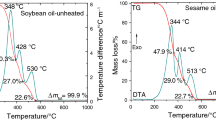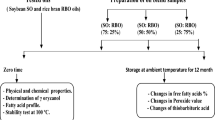Abstract
The stability parameters of 22 samples of soybean oil produced in Mexico were determined. Samples were analyzed for moisture, color, free fatty acids, peroxide value, p-anisidine value, fatty acid profile, metals, flavor, and Rancimat test for oxidative stability. Results obtained were compared with the stability parameters of soybean oil sproduced in the United States and Costa Rica. The fatty acid profile in all samples analyzed corresponded to the expected profile for a 100% soybean oil. Sixty-four percent of the oils had oxidative stabilities similar to those reported for soybean oils from the United States and Costa Rica. This suggests that in spite of the good quality, the soybean oil production process in Mexico needs further improvement. Especially important is maintaining appropriate control during the degumming and bleaching steps. Special consideration should be given to preserving the natural antioxidants present in the oil.
Similar content being viewed by others
References
Soya Bluebook Plus, The Annual Directory of the World Oilseed Industry, Soyatech, Inc., Bar Harbor, 1997, p. 290.
Asbridge, D.D., Soybean vs. Other Vegetable Oils as a Source of Edible Oil Products, in Practical Handbook of Soybean Processing and Utilization, edited by D.R. Erickson, AOCS Press, Champaign, 1995, pp. 3–6.
Emken, E.A., Valor Nutricional del Aceite de Soya en Comparación con Otras Grasas y Aceites, in Boletín de la Asociación Americana de Soya, México, D.F., 1994, p. 1.
Beauregard, L., Producción de Aceite de Soya de Optima Calidad, in Refinación de Aceites Vegetales, edited by Universidad de Sonora, Hermosillo, Sonora, México, 1996, pp. 89–93.
List, G.R., T.L. Mounts, and A.J. Heakin, Steam-Refined Soybean Oil: II. Effect of Degumming Methods on Removal of Prooxidants and Phospholipids, J. Am. Oil Chem. Soc. 55:55–281 (1978).
Gupta, M.K., Processing to Improve Soybean Oil Quality, IN-FORM 4:1267 (1993).
Carelli, A.A., M.I.V. Brevedan, and G.H. Crapiste, Quantitative Determination of Phospholipids in Sunflower Oil, J. Am. Oil Chem. Soc. 74:514 (1997).
Hui, Y.H., Edible Oil and Fat Products: Processing Technology, Bailey’s Industrial Oils and Fats Products, John Wiley & Sons, Inc., Vol. 4, 1996.
Bravo, C.A., La Refinación de Aceites y Grasas Antes y Después de Trisyl, in Extracción y Refinación de Aceites, edited by Universidad de Sonora, Hermosillo, Sonora, Mexico, 1993, pp. 50–53.
Mag, T.K., Bleaching: Theory and Practice, in World Conference Proceedings Edible Fats and Oils Processing: Basic Principles and Modern Practices, edited by D.R. Erickson, American Oil Chemists’ Society Press, Champaign, 1990, pp. 107–116.
Villa, V.M., Operaciones Críticas Durante el Blanqueo, in Refinación de Aceites Vegetales, edited by Universidad de Sonora, Hermosillo, Sonora, México, 1996, pp. 96–99.
Zehnder, C.T., Deodorization, in Practical Handbook of Soybean Processing and Utilization, edited by D.R. Erickson, AOCS Press, Champaign, 1995, pp. 239, 240.
Erickson, D.R., Overview of Modern Soybean Processing and Link Between Processes, in Ibid., edited by D.R. Erickson, AOCS Press, Champaign, 1995, pp. 62–64.
Official Methods and Recommended Practices of the American Oil Chemists’ Society, American Oil Chemists’ Society, 4th edn., AOCS Press, Champaign, 1994.
Lusas, E.W., and, E. Hernandez, Principles of Analysis and Quality Control for Oil Extraction and Processing, in Vegetable Oils Processing, edited by E.W. Lusas, E. Hernandez, L.R. Watkins, and S.C. Doty, Texas A&M University, College Station, 1993, p.22.
Henderson, J.H., R.F. Ariansz, D.R. Taylor, and C.B. Ungermann, Efectos del Blanqueo en los Indices de Peróxido y Anisidina de Aceite de Soya, in Soybean Extraction and Oil Processing, edited by S.C. Doty, E.W. Lusas, and L.R. Watkins, Texas A&M, College Station, 1992, p. 11.
Matthäus, B.W., Determination of the Oxidative Stability of Vegetable Oils by Rancimat and Conductivity and Chemiluminescence Measurements, J. Am. Oil Chem. Soc. 73:1039–1043 (1996).
Méndez, E., J. Sanhueza, H. Speisky, and A. Valenzuela, Validation of the Rancimat Test for the Assessment of the Relative Stability of Fish Oils, Ibid.:1033–1037 (1996).
Norma Oficial Mexicana NOM F 252 1985, Alimentos Aceite Comestible Puro de Soya, Secretaría de Comercio y Fomento Industrial, México, 1985, p. 5.
Author information
Authors and Affiliations
Corresponding author
About this article
Cite this article
Medina-Juárez, L.A., González-Díaz, P., Gámez-Meza, N. et al. Effects of processing on the oxidative stability of soybean oil produced in Mexico. J Amer Oil Chem Soc 75, 1729–1733 (1998). https://doi.org/10.1007/s11746-998-0324-0
Received:
Accepted:
Issue Date:
DOI: https://doi.org/10.1007/s11746-998-0324-0




